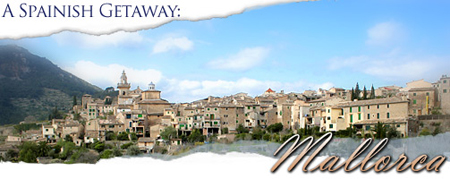|

Mallorca,
Spain - A Holland America Port
As
a Holland America Mediterranean Cruise
port, the large island of Mallorca gives
visitors a chance to experience Spain's
Balearic Islands archipelago. Mallorca,
known for its extensive history, offers
not only a look at the best in Spanish
architecture, but a glimpse at some
of the most beautiful cathedrals.
What
to See
Native son Guillermo Sagrera designed
the Llotja, Mallorca's 15th-Century
commodities exchange. Its rich carving
incorporates a fortified, defensive
façade, but the interior is as
elegant as architecture gets. Near the
old harbor, there is no way to miss
the Llotja. Behind the graceful structure
Mansion del Arte are some of Francisco
Goya's etchings and original works by
Pablo Picasso.
Palma's gothic La Seu Cathedral is one
of the most recognizable city landmarks.
Constrcution on the building beganin
the 13th century, but it took 300 years
to complete. The Cathedral is the final
resting place for the Mallorcan kings,
as their tombs line the chapel. There
are many steps, but the ornate interior
- designed, in part by Barcelona architect
Antonio Gaudi - is worth the climb.
Perhaps most impressive is the enormous
harbor-side doorway.
As the former residence of the Arab
kings, Palacio de la Almudaina became
the royal house of Mallorca when the
Balearics gained their independence.
The palace is directly in front of the
Cathedral, and offers an excellent collection
of paintings. The altarpiece in pretty
Iglesia de Santa Ana dates from the
15th Century. Take time to note the
elegant Moorish architecture. The flowing
construction dates from the 12th Century
represents the final Islamic contributions
to Mellorca, as the Arabs were expelled
in the 13th Century.
One of Mallorca's most beautiful villages,
Real Cartuja de Valldemosa, is not a
far trip from Palma. The views from
the town are dazzling, and a special
interest to visitors is the Cartuja
- a Carthusian Monastery where novelist
George Sand and composer Frederic Chopin
spent the winter of 1838. Tours visit
some of the 14th-Century cells in which
the two, shunned by villagers, found
solace together. Sand completed the
story in her piece, Un Hiver a Majorque
(A Winter in Mallorca) while staying
in Cartuja.
Also take time to visit the El Pueblo
Espanol (Spanish Village), a showcase
of palaces, monuments and typical houses
from all regions of the nation. Architectural
admirers will enjoy a visit to the representative
model village.
It doesn't take long to cross to the
eastern shore, and Porto Cristo is only
50 miles away. Not far from town, archaeological
sites at Sa Gruta and Son Moro reveal
evidence of primitive societies, and
in town, there is a Roman basilica.
Just west, at Cuevas del Drach, fanciful
names have been given to the alluring
stalactite and stalagmite formations.
Nearby Manacor is center of the Mallorcan
pearl industry.
One and a half miles from the city's
center is Bellver Castle, a splendid
Gothic fortification more than 600 years
old. Built to be the summer home of
Mallorcan Kings, it was pressed into
use as a prison and remained one for
most of its history. Built by Jamie
II, the beautifully-preserved fortress
has a museum full of interesting Roman
artifacts. From the tower, travelers
can get a splendid view of the city
and bay.
History
Mallorca is the largest of the Balearic
Islands. The archipelago consists of
five main islands —Mallorca, Minorca,
Ibiza, Formentera and Cabrera. The area
is a self-governing province of Spain.
Many battles have been fought over these
islands. The Moors were here for some
time, and visitors will still find relics
of their remarkable culture. The islands
were also an independent kingdom for
a period of time in the 13th Century,
and although this period was brief,
the Kings of Mallorca made themselves
known throughout Southern Europe.
Read
more about the Holland
America 10-Day Mediterranean Cruise.
|